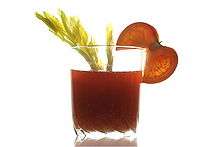Tomato juice
Tomato juice is a juice made from tomatoes, usually used as a beverage, either plain or in cocktails such as a Bloody Mary, a Caesar, or Michelada.

| Nutritional value per 100 g (3.5 oz) | |
|---|---|
| Energy | 73 kJ (17 kcal) |
3.53 g | |
| Sugars | 2.58 g |
| Dietary fiber | 0.4 g |
0.29 g | |
0.85 g | |
| Vitamins | Quantity %DV† |
| Vitamin C | 84% 70.1 mg |
| Other constituents | Quantity |
| Water | 94.24 g |
| |
| †Percentages are roughly approximated using US recommendations for adults. Source: USDA Nutrient Database | |
History
Tomato juice was first served as a beverage in 1917 by Louis Perrin at the French Lick Springs Hotel in southern Indiana, when he ran out of orange juice and needed a quick substitute. His combination of squeezed tomatoes, sugar and his special sauce became an instant success as Chicago businessmen spread the word about the tomato juice cocktail.[1][2]
Production
Many commercial manufacturers of tomato juice also add salt. Other ingredients are also often added, such as onion powder, garlic powder, and other spices. In the United States, mass-produced tomato juice began to be marketed in the mid 1920s, and became a popular breakfast drink a few years thereafter.[3]
In the United States, most tomato juice is made from tomato paste.[4] In Canada, tomato juice is unconcentrated and pasteurized, made from fine tomato pulp from ripe and whole tomatoes. The stems and skins must be removed without adding water to the final juice product. It may also contain a sweetening agent, citric acid and salt.[5]
Uses
In Canada and Mexico, tomato juice is commonly mixed with beer; the concoction is known in Canada as Calgary Red-Eye, and in Mexico as Cerveza preparada. Tomato juice is the base for the cocktails Bloody Mary and Bloody Caesar, and the cocktail mixer Clamato. In the UK tomato juice is commonly combined with Worcestershire sauce.
Chilled tomato juice was formerly popular as an appetizer at restaurants in the United States.[6]
Tomato juice is frequently used as a packing liquid for canned tomatoes, though it is sometimes replaced by tomato purée for international commerce due to tariff issues on vegetables vs. sauces. According to Cook's Illustrated magazine, tomatoes packed in juice as opposed to purée tend to win taste tests, being perceived as fresher tasting.[7]
Tomato juice is used in the preparation of tomato juice agar, used to culture various species of Lactobacillus.
Tomato juice is a popular drink among airplane passengers. A small study by Yan and Dando hints that this is due to an increased perception of umami flavor while in the loud and pressurized environment of the cabin.[8] An alternative explanation is that it has become tradition similar to eating popcorn at the cinema.
See also
References
| Look up tomato juice in Wiktionary, the free dictionary. |
| Wikimedia Commons has media related to Tomato juice. |
- Anne Hattes. "Tomato Juice". Relish, August 2009.
- "History". French Lick Springs Hotel.
- Kathleen Morgan Drowne; Patrick Huber. Nineteen Twenties. p. 122.
- "Heinz deal to save hundreds of jobs at Leamington plant". CBC News. February 26, 2004.
- Branch, Legislative Services. "Consolidated federal laws of canada, Food and Drug Regulations". laws.justice.gc.ca. Retrieved July 18, 2017.
- "Taste of the '60s: The Way Things Were". Washingtonian. November 2013.
- "Crushed Tomatoes". Cook's Illustrated. May 2007.
- Yan, Kimberly S.; Dando, Robin (March 16, 2015). "A Crossmodal Role for Audition in Taste Perception" (PDF). Journal of Experimental Psychology: Human Perception and Performance. 41 (3): 590–596. doi:10.1037/xhp0000044.
